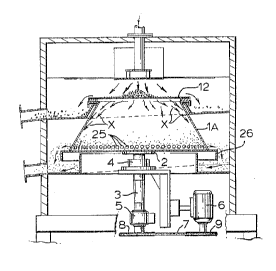Some of the information on this Web page has been provided by external sources. The Government of Canada is not responsible for the accuracy, reliability or currency of the information supplied by external sources. Users wishing to rely upon this information should consult directly with the source of the information. Content provided by external sources is not subject to official languages, privacy and accessibility requirements.
Any discrepancies in the text and image of the Claims and Abstract are due to differing posting times. Text of the Claims and Abstract are posted:
| (12) Patent: | (11) CA 2097313 |
|---|---|
| (54) English Title: | A ROTARY SCREEN DEVICE |
| (54) French Title: | CRIBLE ROTATIF |
| Status: | Deemed expired |
| (51) International Patent Classification (IPC): |
|
|---|---|
| (72) Inventors : |
|
| (73) Owners : |
|
| (71) Applicants : |
|
| (74) Agent: | ROBIC |
| (74) Associate agent: | |
| (45) Issued: | 1998-08-04 |
| (86) PCT Filing Date: | 1991-11-28 |
| (87) Open to Public Inspection: | 1992-05-30 |
| Examination requested: | 1994-07-08 |
| Availability of licence: | N/A |
| (25) Language of filing: | English |
| Patent Cooperation Treaty (PCT): | Yes |
|---|---|
| (86) PCT Filing Number: | PCT/GB1991/002107 |
| (87) International Publication Number: | WO1992/009375 |
| (85) National Entry: | 1993-05-28 |
| (30) Application Priority Data: | ||||||
|---|---|---|---|---|---|---|
|
In a rotary screening device the screen or sieve (12) is stretched across the upper end of the drum (1A) which is rotated
about the vertical axis, and the walls of the drum (1A) are frusto-conical or of parabolic section, diverging outwardly to its lower
end in order to avoid "caking" of the sieved particles on the inside of the walls. The walls may be polished or coated with PTFE.
Dans un crible rotatif, le tamis ou crible (12) est étiré en travers de l'extrémité supérieure du tambour (1A) qui est animé d'un mouvement de rotation sur son axe vertical; les parois du tambour (1A), de section frusto-conique ou parabolique, divergent vers l'extérieur à la partie inférieure du tambour afin de prévenir l'agglutination ou le mottage des particules à la surface intérieure des parois. Les parois du tambour peuvent être polies ou revêtues d'une couche de produit PTFE.
Note: Claims are shown in the official language in which they were submitted.
Note: Descriptions are shown in the official language in which they were submitted.

For a clearer understanding of the status of the application/patent presented on this page, the site Disclaimer , as well as the definitions for Patent , Administrative Status , Maintenance Fee and Payment History should be consulted.
| Title | Date |
|---|---|
| Forecasted Issue Date | 1998-08-04 |
| (86) PCT Filing Date | 1991-11-28 |
| (87) PCT Publication Date | 1992-05-30 |
| (85) National Entry | 1993-05-28 |
| Examination Requested | 1994-07-08 |
| (45) Issued | 1998-08-04 |
| Deemed Expired | 2001-11-28 |
There is no abandonment history.
| Fee Type | Anniversary Year | Due Date | Amount Paid | Paid Date |
|---|---|---|---|---|
| Application Fee | $0.00 | 1993-05-28 | ||
| Maintenance Fee - Application - New Act | 2 | 1993-11-29 | $100.00 | 1993-10-07 |
| Registration of a document - section 124 | $0.00 | 1993-11-16 | ||
| Request for Examination | $400.00 | 1994-07-08 | ||
| Maintenance Fee - Application - New Act | 3 | 1994-11-28 | $100.00 | 1994-10-27 |
| Maintenance Fee - Application - New Act | 4 | 1995-11-28 | $100.00 | 1995-10-25 |
| Maintenance Fee - Application - New Act | 5 | 1996-11-28 | $150.00 | 1996-10-29 |
| Maintenance Fee - Application - New Act | 6 | 1997-11-28 | $150.00 | 1997-10-29 |
| Final Fee | $300.00 | 1998-03-02 | ||
| Maintenance Fee - Patent - New Act | 7 | 1998-11-30 | $150.00 | 1998-10-13 |
| Maintenance Fee - Patent - New Act | 8 | 1999-11-29 | $150.00 | 1999-10-13 |
Note: Records showing the ownership history in alphabetical order.
| Current Owners on Record |
|---|
| ECC INTERNATIONAL LIMITED |
| Past Owners on Record |
|---|
| FALCON-STEWARD, HUGH ROBIN |
| JONES, THOMAS RICHARD |
| PHILLIPS, REGINALD LEYLAND |